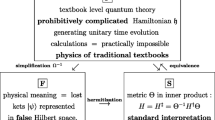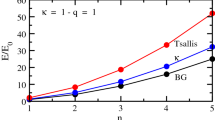Abstract
Considering the position-dependent effective mass in the study of quantum mechanical systems, a wide range of solvable potentials has been obtained. These potentials are obtained by applying canonical transformations to the Schrödinger equation. In this method, the internal functions introduced by Levai for solvable potentials with constant mass have been used, and the eigenfunctions and eigenvalues have been fully obtained. The eigenfunction of these solvable potentials can be obtained based on orthogonal polynomials (Jacobian, generalized Laguerre and Hermite polynomials). Some of these potentials are Scarf-II, Pöschl-Teller, Rosen-Mörse-II and Eckart, whose applications have been described in physical systems. Finally, all the results are placed in a table and the figures of the desired functions are drawn for specific values.












Similar content being viewed by others
Data Availability
All data generated or analysed during this study are included in this published article.
References
D.J. Bendaniel, C.B. Duke, Space-charge effects on electron tunneling. Phys. Rev. J. Arch. 152, 683 (1966)
D. Bessis, G. Mezincescu, Design of semiconductor heterostructures with preset electron reflectance by inverse scattering techniques. Microelectron. J. 30, 953–974 (1999)
G. Bastard, Wave Mechanics Applied to Semiconductor Heterostructures (Edition physiques, Les Ulis, 1988)
V. Milanovic, Z. Ikonic, Equispaced-level Hamiltonians with the variable effective mass following the potential. Phys. R. B 54, 1998 (1996)
O.M. Von Roos, Position-dependent effective masses in semiconductor theory. Phys. Rev. B 27, 7547 (1983)
P. Rings, P. Schuck, Nucl. Many-Body Probl. (SpringerVerlag, New York, 1980)
L.I. Serra, E. Lipparini, Spin response of unpolarized quantum dots. Europhysics. Letters 40, 667 (1997)
A. Puente, L. Serra, M. Casas, Dipole excitation of Na clusters with a non-local energy density functional. Z Phys D-Atoms, Mol. Clust. 31, 283–286 (1994)
M.R. Geller, W. Kohn, Quantum mechanics of electrons in crystals with graded composition. Phys. Rev. Lett. 70, 3103 (1993)
F. Arias de Saavedra, J. Boronat, A. Polls, A. Fabrocini, Effective mass of one \(He^{4}\) atom in liquid \(He^{3}\). Phys. Rev. B 50, 4248 (1994)
M. Barranco, M. Pi, S.M. Gatica, E.S. Hernandez, J. Navarro, Structure and energetics of mixed \(He^{4}-He^{3}\) drops. Phys. Rev. B 56, 8997 (1997)
K. Samani, F. Loran, Shape invariant potentials for effective mass Schrödinger equation, quant-ph\(\backslash \)0302191v1, (2003)
Y. Alhassid, F. Gursey, F. Iachello, Group theory approach to scattering. II the euclidean connection. Ann. Phys. 167, 181–200 (1986)
G. Levai, Solvable potentials associated with su(1, 1) algebras: a systematic study. J. Phys. A: Math. Gen. 27, 3809 (1994)
J.W. Dabrowska, A. Khare, U.P. Sukhatme, Explicit wavefunctions for shape-invariant potentials by operator techniques. J. Phys. A: Math. Gen. 21, L195 (1988)
G. Levai, A search for shape-invariant solvable potentials. J. Phys. A: Math. Gen. 22, 689 (1989)
R. De, R. Dutt, U. Sukhatme, Mapping of shape invariant potentials under point canonical transformations. J. Phys. A: Math. Gen. 25, L843 (1992)
L. Infeld, T.E. Hull, The factorization method. Rev. Mod. Phys. 23, 21 (1951)
E. Witten, Dynamical breaking of supersymmetry. Nucl. Phys. B 185, 513–554 (1981)
L.E. Gendenshtein, Derivation of exact spectra of the Schrödinger equation by means of supersymmetry. JETP Lett. 38, 356 (1983)
F. Cooper, A. Khare, U. Sukhatme, Supersymmetry and quantum mechanics. Phys. Rep. 251, 267–385 (1995)
M.J. Engelfield, C. Quesne, Dynamical potential algebras for Gendenshtein and Morse potentials. J. Phys. A: Math. Gen. 24, 3557 (1991)
V. Milanovic, Z. Ikonic, Generation of isospectral combinations of the potential and the effective-mass variations by supersymmetric quantum mechanics. J. Phys. A: Math. Gen. 32, 7001 (1999)
A.R. Plastino, A. Rigo, M. Casas, F. Garcias, A. Plastino, Supersymmetric approach to quantum systems with position-dependent effective mass. Phys. Rev. A 60, 4318 (1999)
B. Gonul, B. Gonul, D. Tutcu, O. Ozer, Supersymmetric approach to exactly solvable systems with position-dependent effective masses. Mod. Phys. Lett. A 17, 2057–2066 (2002)
C. Quesne, V.M. Tkachuk, Moreon a SUSYQM approach to the harmonic oscillator with nonzero minimal uncertainties in position and/or momentum. J. Phys. A: Math. Gen. 37, 10095 (2004)
B. Roy, P. Roy, A Lie algebraic approach to effective mass Schrödinger equations. J. Phys. A: Math. Gen. 35, 3691 (2002)
C. Quesne, V.M. Tkachuk, Deformed algebras position-dependent effective masses and curved spaces: an exactly solvable Coulomb problem. J. Phys. A: Math. Gen. 37, 4267 (2004)
B. Bagchi, A. Banerjee, C. Quesne, V.M. Thachak, Deformed shape invariance and exactly solvable Hamiltonians with position-dependent effective mass. J. Phys. A: Math. Gen. 38, 2929–2945 (2005)
R. Koc, M. Koca, A systematic study on the exact solution of the position dependent mass Schrödinger equation. J. Phys. A: Math. Gen. 36, 8105–8112 (2003)
A.D. Alhaidari, Solutions of the nonrelativistic wave equation with position-dependent effective mass. Phys. Rev. A 66, 042116 (2002)
B. Bagchi, P. Gorain, C. Quesne, R. Roychoudhury, A general scheme for the effective-mass Schrödinger equation and the generation of the associated potentials. Mod. Phys. Lett. A 19(37), 2765–2775 (2004)
B. Bagchi, P. Gorain, C. Quesne, R. Roychoudhury, New approach to (quasi-) exactly solvable Schrödinger equations with a position-dependent effective mass. Europhys. Lett. 72, 155 (2005)
H. Panahi, Z. Bakhshi, Solvable potentials with position-dependent effective mass and constant mass Schrödinger equation. Acta Phys. Polonica B 41, 11 (2010)
X.Q. Zhao, C.S. Jia, Q.B. Yang, Bound states of relativistic particles in the generalized symmetrical double-well potential. Phys. Lett. A 337, 189–196 (2005)
A.J. Peter, K. Navaneethakrishnan, Effects of position-dependent effective mass and dielectric function of a hydrogenic donor in a quantum dot. Phys. E 40, 2747–2751 (2008)
S. Rajashabala, K. Navaneethakrishnan, Effective masses for donor binding energies in non-magnetic and magnetic quantum well systems: effect of magnetic field. Braz. J. Phys. 37, 1134 (2007)
S. Rajashabala, K. Navaneethakrishnan, Effective masses for donor binding energies in quantum well systems. Mod. Phys. Lett. B 24, 1529–1541 (2006)
Y.X. Li, J.J. Liu, X.J. Kong, The effect of a spatially dependent effective mass on hydrogenic impurity binding energy in a finite parabolic quantum well with a magnetic field. J. Appl. Phys. 88, 2588 (2000)
R. Khordad, B. Mirhosseini, Effect of variable effective mass on optical properties of quantum rod. Iran. J. Phys. Res. 13, 375 (2014)
G. Bastard, Superlattice band structure in the envelope-function approximation. Phys. Rev. B 24, 5693 (1981)
Q.G. Zhu, H. Kroemer, Interface connection rules for effective-mass wave functions at an abrupt heterojunction between two different semiconductors. Phys. Rev. B 27, 3519 (1983)
T.L. Li, K. Kuhn, Band-offset ratio dependence on the effective-mass Hamiltonian based on a modified profile of the \(GaAs-Al_{x}Ga_{1-x}As\) quantum well. J. Phys. Rev. B 47, 12760 (1993)
W. Jr, Miller, Lie Theory of Special Functions (Academic, New York, 1968)
H. Li, D. Kusnezov, Group theory approach to band structure: scarf and lamé hamiltonians. Phys. Rev. Lett. 83, 1283 (1999)
J.-P. Antoine, J.-P. Gazeau, P. Monceau, J.R. Klauder, K.A. Penson, Temporally stable coherent states for infinite well and Pöschl-Teller potentials. J. Math. Phys. 42, 2349 (2001)
D.E. Alvarez-Castillo, M. Kirchbach, Exact spectrum and wave functions of the hyperbolic Scarf potential in terms of finite Romanovski polynomials. Revista mexicana de física E 53, 143–154 (2007)
B.N. Pratiwi, A. Suparmi, C. Cari, A.S. Husein, Asymptotic iteration method for the modified Pöschl-Teller potential and trigonometric scarf II non-central potential in the Dirac equation spin symmetry. Pramana-J. Phys. 88, 1–9 (2017)
R.L. Brown, A method of calculating tunneling corrections for Eckart potential barriers. J. Res. Nat. Bur. Stand. 86, 20234 (1981)
N. Rosen, P.M. Morse, On the vibrations of polyatomic molecules. Phys. Rev. 42, 210 (1932)
Author information
Authors and Affiliations
Corresponding author
Rights and permissions
Springer Nature or its licensor holds exclusive rights to this article under a publishing agreement with the author(s) or other rightsholder(s); author self-archiving of the accepted manuscript version of this article is solely governed by the terms of such publishing agreement and applicable law.
About this article
Cite this article
Bakhshi, Z., Khoshdooni, S. Classification of quantum systems with position-dependent effective mass based on lie algebra and special functions. Eur. Phys. J. Plus 137, 931 (2022). https://doi.org/10.1140/epjp/s13360-022-03136-1
Received:
Accepted:
Published:
DOI: https://doi.org/10.1140/epjp/s13360-022-03136-1




